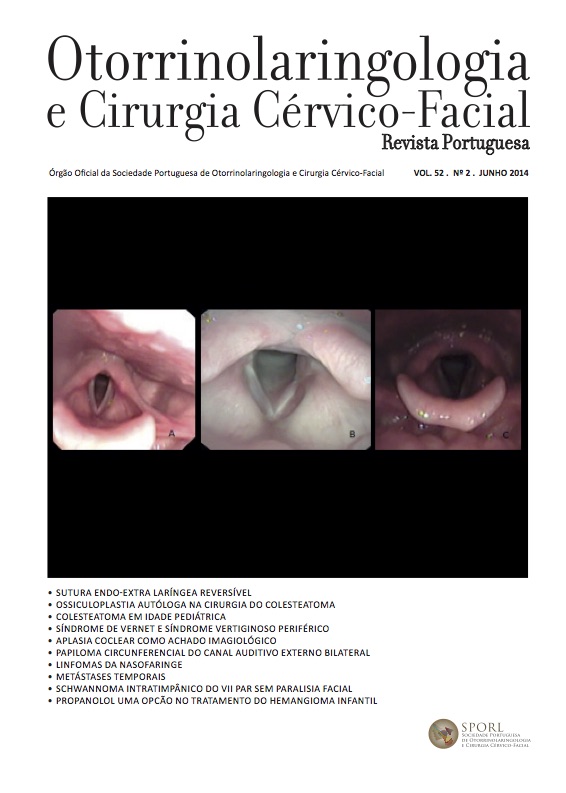Intratympanic VII nerve schwannoma without facial paralysis: A rare cause of aural polyp
DOI:
https://doi.org/10.34631/sporl.465Keywords:
Schwannoma, facial nerve, middle ear tumours, aural polyp, facial paralysisAbstract
Facial nerve schwannomas are the second most common type of benign neoplasia of the middle ear after paragangliomas. When their origin is intratympanic, signs and symptoms develop earlier. The most frequent complaints are facial paralysis and hypoacusis.
We report the case of a patient with unilateral conductive hypoacusis, an aural polyp and imagiologic changes suggesting a middle ear schwannoma. The diagnosis was confirmed by pathology after full excision of the lesion through radical mastoidectomy. In the post-operative period, the hearing loss is unchanged and the patient has normal facial function (I/VI, House-Brackmann).
The absence of facial paralysis is an uncommon presentation for these lesions and we have found only two cases reported with aural polyp and no facial paralysis. The full excision of these extensive lesions can be performed while maintaining the pre-operative hearing thresholds and facial function.
Downloads
References
Kim CW, Han DH, Kim CH, Cho SJ, et al. Primary middle ear schwannoma. Am J Otolaryngol. 2007;28(5):342-6.
Roig ORJ, Roig-Ocampos FJ, Serafini DP, Lopez Filho O. Middle ear Schwannoma. Braz J Otorhinolaryngol. 2010;76(5):673.
Biswas D, Marnane CN, Mal RK, Baldwin DL. The presenting features of middle ear facial nerve sheath tumors: a clinical review. Am J Otolaryngol. 2008;29(1):58-62.
Kirazli T, Oner K, Bilgen C, Ovul I, et al. Facial nerve neuroma: clinical, diagnostic, and surgical features. Skull Base. 2004;14(2):115-20.
Park SH, Kim J, Moon IS, Lee WS. The best candidates for nervesparing stripping surgery for facial nerve schwannoma. Laryngoscope. 2014 Nov;124(11):2610-5.
Wiggins RH, 3rd, Harnsberger HR, Salzman KL, Shelton C, et al. The many faces of facial nerve schwannoma. AJNR Am J Neuroradiol. 2006;27(3):694-9.
Okabe Y, Nagayama I, Takiguchi T, Furukawa M. Intratemporal facial nerve neurinoma without facial paralysis. Auris Nasus Larynx. 1992;19(4):223-7.
Sharp JF, Kerr AI, Carder P, Sellar RJ. Facial schwannoma without facial paralysis. J Laryngol Otol. 1989;103(10):973-5.
Alyono JC, Corrales CE, Gurgel RK, Blevins N, Jackler RK. Facial nerve schwannomas presenting as occluding external auditory canal masses: a therapeutic dilemma. Otol Neurotol. 2014 Aug;35(7):1284-9.
McRackan TR, Rivas A, Wanna GB, Yoo MJ, et al. Facial nerve outcomes in facial nerve schwannomas. Otol Neurotol. 2012
Jan;33(1):78-82.
Li Y1, Liu H, Cheng Y. Subtotal resection of facial nerve schwannoma is not safe in the long run. cta Otolaryngol. 2014 Apr;134(4):433-6.
McMonagle B, Al-Sanosi A, Croxson G, Fagan P. Facial schwannoma: results of a large case series and review. J Laryngol Otol.
;122(11):1139-50.
Kim CS, Chang SO, Oh SH, Ahn SH, et al. Management of intratemporal facial nerve schwannoma. Otol Neurotol.
;24(2):312-6.
Wilkinson EP, Hoa M, Slattery WH 3rd, Fayad JN, et al. Evolution in the management of facial nerve schwannoma. Laryngoscope. 2011 Oct;121(10):2065-74.
Ingrosso G, Ponti E, di Cristino D, Terenzi S, et al. Intra-parotid facial nerve schwannoma with intra-temporal extension; a case report. Is there a role for stereotactic radiotherapy? Am J Otolaryngol. 2013 May-Jun;34(3):258-61.
Elsharkawy M, Xu Z, Schlesinger D, Sheehan JP. Gamma Knife surgery for nonvestibular schwannomas: radiological and clinical outcomes. J Neurosurg. 2012 Jan;116(1):66-72.






